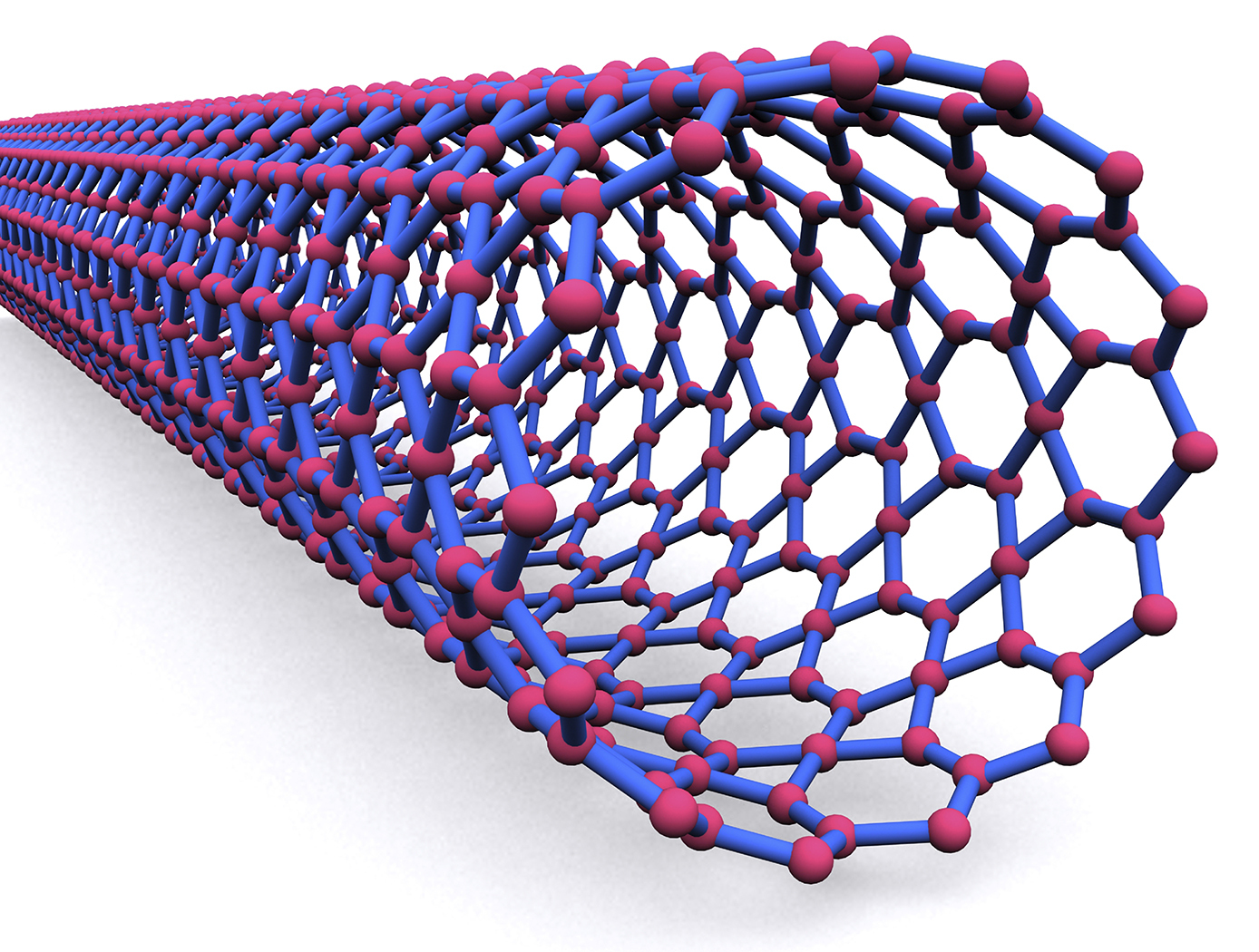Functionalization of Single-Wall Carbon Nanotubes
materials and coatings
Functionalization of Single-Wall Carbon Nanotubes (LEW-TOPS-64)
A new technique for carbon nanotube oxidation
Overview
A new technique for carbon nanotube oxidation based upon the photo-oxidation of organic compounds was developed by NASA's Glenn Research Center. Single-wall carbon nanotubes (SWCNTs) have a nearly fivefold higher Young's modulus, a tenfold higher tensile strength, and three times the elongation at break of conventional carbon fibers. In addition, they have electrical and thermal conductivities that are nearly ten times that of high conductivity carbon fibers. Use of SWCNTs as additives to polymers has been shown to significantly increase their mechanical, electrical, and thermal properties. Functionalization of single-wall carbon nanotubes improves their ability to be incorporated into polymer matrices and enhances their bonding with the matrix. NASA Glenn's new technique for carbon nanotube oxidation was developed upon the photo-oxidation of organic compounds. The resulting method is more benign than conventional oxidation approaches and produces SWCNTs with higher levels of oxidation.
The Technology
In Glenn's technique, SWCNTs are dispersed in a suitable solvent, such as N-methyl pyrollidinone, and the resulting suspension is saturated with oxygen gas. A singlet oxygen sensitizer is added and the resulting mixture is irradiated under a continuous flow of oxygen for many hours. The resulting oxidized tubes are recovered by filtering the suspension, washing them, and then drying them in a vacuum oven. Singlet oxygen is a highly reactive species and is known to add to a variety of aromatic carbons. Singlet oxygen is prepared by irradiating an oxygen saturated solution with ultraviolet light in the presence of a sensitizer. This method may also be suitable for use in oxidation of multi-wall carbon nanotubes and graphenes.
This is an early-stage technology requiring additional development. Glenn welcomes co-development opportunities.


Benefits
- Better oxidation: Oxidation levels using this method are nearly twice that obtained by conventional oxidation
- Safer: Does not require the use of toxic oxidizing agents or corrosive acids
Applications
- Aerospace (e.g., structures to mitigate lightning strikes)
- Automotive
- Composites
- High-performance sports
- Protective gear
Similar Results

Conductive Polymer/Carbon Nanotube Structural Materials and Methods for Making Same
Carbon nanotubes (CNTs) show promise for multifunctional materials for a range of applications due to their outstanding combination of mechanical, electrical and thermal properties. However, these promising mechanical properties have not translated well to CNT nanocomposites fabricated by conventional methods due to the weak load transfer between tubes or tube bundles.
In this invention, the carbon nanotube forms such as sheets and yarns were modified by in-situ polymerization with polyaniline, a -conjugated conductive polymer. The resulting CNT nanocomposites were subsequently post-processed to improve mechanical properties by hot pressing and carbonization. A significant improvement of mechanical properties of the polyaniline/carbon nanotube nanocomposites was achieved through a combination of stretching, polymerization, hot pressing, and carbonization.

Dispersion of Carbon Nanotubes in Polymers
The technology portfolio spans several methods for dispersion and processing of CNTs in polymer resins and composites. CNT/resin systems with high dispersion and long-term stability are provided by three general approaches. One method relies on mechanical dispersion by sonication simultaneous with partial polymerization to increase the resin viscosity to maintain dispersion and enable further polymer processing of the CNT blend into films and other articles. Another approach relies on what is termed donor acceptor bonding, which essentially is a dipole bond created on the CNT/resin interface to maintain dispersion and stability of the CNT/resin blend. This dispersion method also provides advantages in mechanical properties of processed composites due to the interface characteristics. A range of polymer types can be used, including polymethyl methacrylate, polyimide, polyethylene, and others.
An additional dry blending approach provides advantages for a variety of
thermoplastic and thermoset systems. Use of ball mill mixing achieves effective
blending and dispersion of the CNT, even at high loadings. Further processing steps
using injection molding or similar melt processing methods have yielded CNT/
polymer composites with a range of useful electronic, optical, and mechanical
properties.

Conductive Carbon Fiber Polymer Composite
The new composite developed by NASA incorporates PGS and CNTs to enhance its thermal conductivity while preserving the mechanical properties of the underlying carbon fiber polymer composite. NASA has also improved the composite manufacturing process to ensure better thermal conductivity not only on the surface, but also through the thickness of the material. This was achieved by adding perforations that enable the additives to spread through the composite.
The process for developing this innovative, highly thermally conductive hybrid carbon fiber polymer composite involves several steps. Firstly, a CNT-doped polymer resin is prepared to improve the matrix's thermal conductivity, which is then infused into a carbon fiber fabric. Secondly, PGS is treated to enhance its mechanical interface with the composite. Thirdly, perforation is done on the pyrolytic graphite sheet to improve the thermal conductivity through the thickness of the material by allowing CNT-doped resin to flow and better interlaminar mechanical strength. Finally, the layup of PGS and CNT-CF polymer is optimized.
Initial testing of the composite has shown significant increases in thermal conductivity compared to typical carbon fiber composites, with a more than tenfold increase. The composite also has higher thermal conductivity than aluminum alloys, with more than twice the thermal conductivity of the Aluminum 6061 typically used in the aerospace industry. For this new material, NASA has completed a proof-of-concept demonstration and work continues to use the material in a heat exchanger system and further characterize the properties including longevity and radiation impact analysis.

Gas Sensors Based on Coated and Doped Carbon Nanotubes
A typical sensor device includes a set of interdigitated microelectrodes fabricated by photolithography on silicon wafer or an electrically insulating substrate. In preparation for fabricating the SWCNT portion of such a sensor, a batch of treated (coated or doped) SWCNTs is dispersed in a solvent. The resulting suspension of SWCNTs is drop-deposited or injected onto the area containing the interdigitated electrodes. As the solvent evaporates, the SWCNTs form a mesh that connects the electrodes. The density of the SWCNTs in the mesh can be changed by varying the concentration of SWCNTs in the suspension and/or the amount of suspension dropped on the electrode area. To enable acquisition of measurements for comparison and to gain orthogonality in the sensor array, undoped SWCNTs can be similarly formed on another, identical set of interdigitated electrodes. Coating materials tested so far include chlorosulfonated polyethylene. Dopants that have been tested include Pd, Pt, Au, Cu and Rh nanoparticle clusters. To date, the sensor has been tested for NO2, NH3, CH4, Cl2, HCl, toluene, benzene, acetone, formaldehyde and nitrotoulene.

Electrical Response Using Nanotubes on a Fibrous Substrate
A resistor-type sensor was fabricated which has a network of cross-linked SWCNTs with purity over 99%. An ordinary cellulose paper used for filtration was employed as the substrate. The filter paper exhibits medium porosity with a flow rate of 60 mL/min and particle retention of 5-10m. The roughness and porosity of the papers are attractive because they increase the contact area with the ambient air and promote the adhesion to carbon nanotubes. The SWCNTs were functionalized with carboxylic acid (COOH) to render them hydrophilic, thus increasing the adhesion with the substrate. The functionalized SWCNTs were dispersed in dimethylformamide solution. The film composed of networks of cross-linked CNTs was formed using drop-cast coating followed by evaporation of the solvent. Adhesive copper foil tape was used for contact electrodes. Our sensors outperformed the oxide nanowire-based humidity sensors in terms of sensitivity and response/recovery times.



